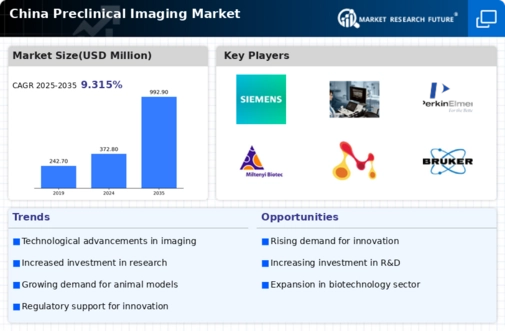The preclinical imaging market in China is characterized by a dynamic competitive landscape, driven by advancements in technology and increasing demand for innovative imaging solutions. Key players such as Bruker Corporation (US), PerkinElmer Inc. (US), and Siemens Healthineers (DE) are at the forefront, each adopting distinct strategies to enhance their market presence. Bruker Corporation (US) focuses on innovation, particularly in the development of high-resolution imaging systems, while PerkinElmer Inc. (US) emphasizes partnerships with research institutions to expand its product offerings. Siemens Healthineers (DE) is actively pursuing digital transformation initiatives, integrating AI capabilities into its imaging solutions, which collectively shapes a competitive environment that is increasingly reliant on technological advancements and strategic collaborations.
In terms of business tactics, companies are localizing manufacturing to reduce costs and enhance supply chain efficiency. The market structure appears moderately fragmented, with several players vying for market share. This fragmentation allows for a diverse range of products and services, but also intensifies competition among key players. The collective influence of these companies is significant, as they continuously innovate and adapt to changing market demands, thereby driving growth in the sector.
In October 2025, Siemens Healthineers (DE) announced the launch of a new AI-driven imaging platform designed to enhance diagnostic accuracy in preclinical studies. This strategic move is likely to position the company as a leader in the integration of AI technologies within imaging, potentially attracting more research partnerships and increasing its market share. The emphasis on AI not only aligns with current trends but also addresses the growing need for precision in preclinical research.
In September 2025, PerkinElmer Inc. (US) expanded its collaboration with a leading Chinese university to develop advanced imaging techniques for cancer research. This partnership is strategically important as it not only enhances PerkinElmer's product portfolio but also strengthens its foothold in the Chinese market, where demand for innovative imaging solutions is surging. Such collaborations may facilitate the development of tailored solutions that meet local research needs, thereby fostering growth.
In August 2025, Bruker Corporation (US) completed the acquisition of a smaller imaging technology firm, which is expected to bolster its capabilities in molecular imaging. This acquisition reflects a broader trend of consolidation within the market, as companies seek to enhance their technological capabilities and expand their service offerings. By integrating new technologies, Bruker aims to provide more comprehensive solutions to its clients, thereby enhancing its competitive edge.
As of November 2025, current trends in the preclinical imaging market include a strong focus on digitalization, sustainability, and the integration of AI technologies. Strategic alliances are increasingly shaping the competitive landscape, as companies recognize the value of collaboration in driving innovation. Looking ahead, competitive differentiation is likely to evolve, with a shift from price-based competition to a focus on technological innovation and supply chain reliability. This transition suggests that companies that prioritize R&D and strategic partnerships will be better positioned to thrive in an increasingly competitive environment.




















Leave a Comment